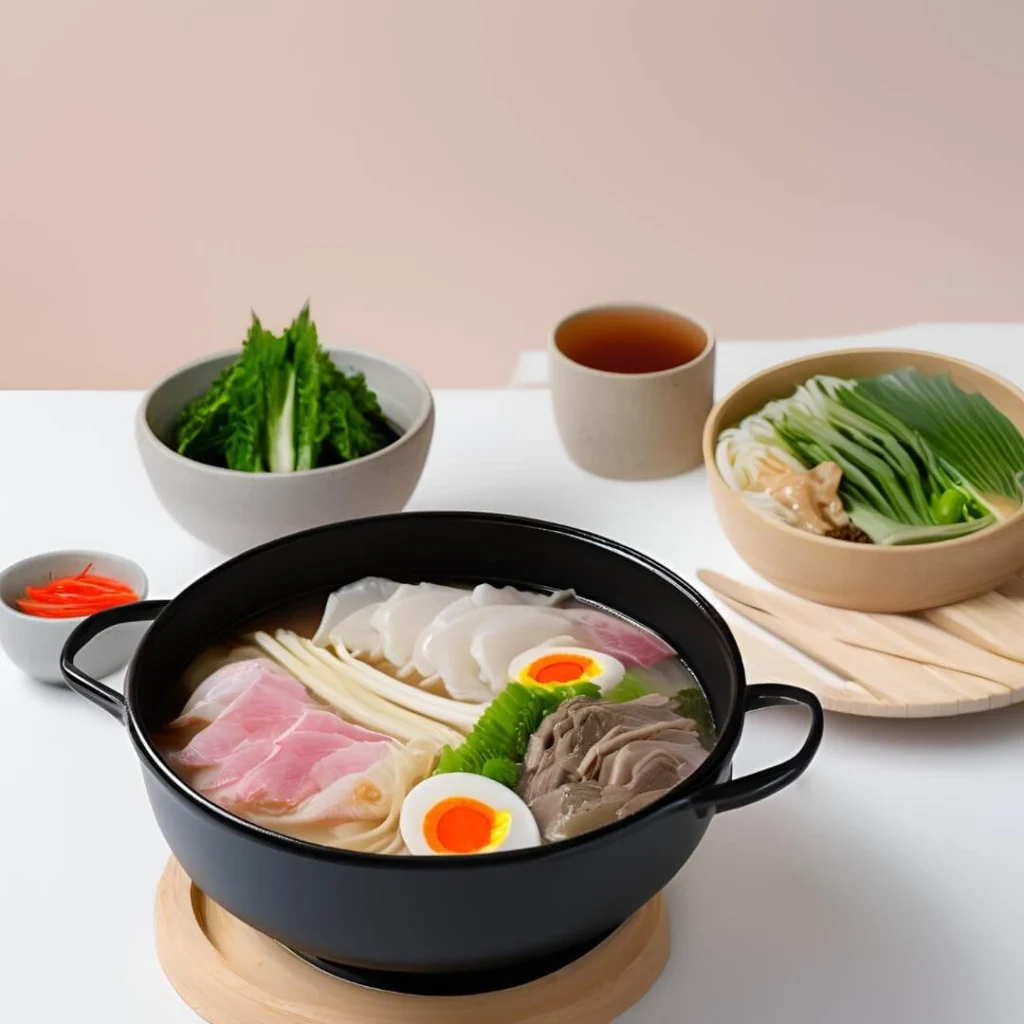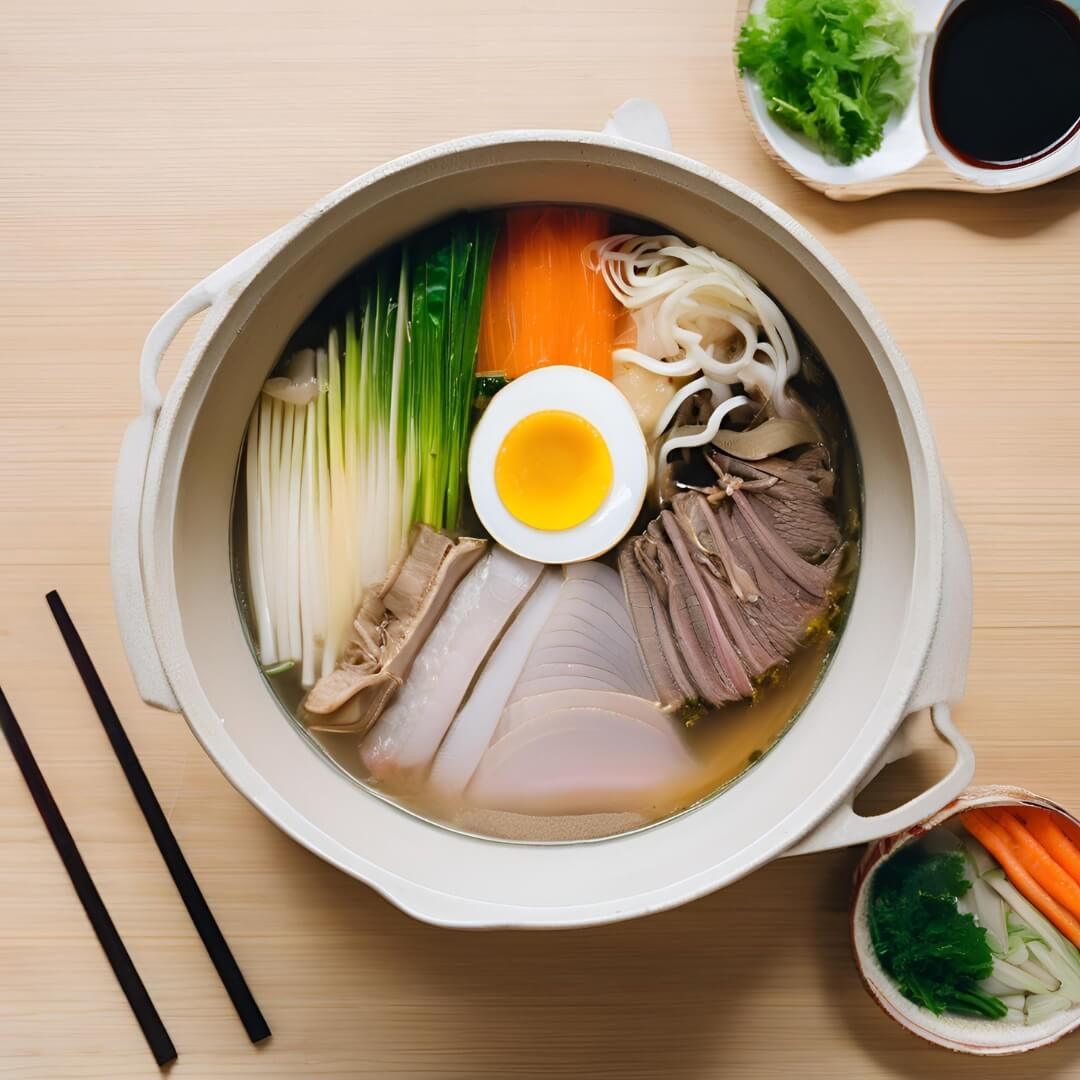Love Japanese flavors? This Japanese Sukiyaki Hot Pot combines tender beef, savory broth, and fresh veggies for a comforting meal. Discover now.
Introduction: Is Sukiyaki Hot Pot the Ultimate Cozy Meal?
Have you ever wondered why Japanese Sukiyaki Hot Pot is such a beloved dish, especially during the colder months? Could it be the rich, savory broth that warms your soul? Or maybe it’s the tender slices of beef, fresh vegetables, and soft tofu simmering together in perfect harmony? If you’ve tasted this dish, you know it’s more than just a meal—it’s an experience. But here’s the real question—what makes sukiyaki so comforting? Is it the ingredients? The communal cooking style? Or the way it brings people together around the table? Let’s uncover why this dish is the ultimate winter warmer.
For more insights into Japanese comfort foods, check out our post on Winter Comfort Foods from Japan .
Overview: Why This Japanese Sukiyaki Hot Pot Recipe Stands Out
Our Japanese Sukiyaki Hot Pot combines high-quality ingredients, simple preparation, and a cozy dining experience to create a dish that’s both satisfying and heartwarming. It’s quick to prepare, customizable, and perfect for sharing with family and friends.
What Makes This Recipe Special?
- Quick Prep Time : In under 45 minutes, you can enjoy a delicious, restaurant-quality hot pot.
- Easy Difficulty Level : With straightforward techniques and accessible ingredients, anyone can master this dish.
- Nutrient-Packed : Thinly sliced beef, fresh vegetables, and nutrient-rich tofu provide a balanced meal full of protein and vitamins.
For more information on the health benefits of Japanese cuisine, explore this resource by Healthline .
Five Steps to the Perfect Japanese Sukiyaki Hot Pot
Here are the five key steps that make this Japanese Sukiyaki Hot Pot truly unforgettable:

1. High-Quality Beef
- Why It’s Important : Thinly sliced wagyu or ribeye beef adds richness and tenderness to the dish.
- Tips : Look for well-marbled cuts for maximum flavor and texture.
2. Sweet Soy Sauce Broth
- Why It’s Important : A mixture of soy sauce, mirin, sake, and sugar creates the signature sweet-savory broth that ties everything together.
- Variations : Adjust sweetness levels based on preference, or add dashi for extra umami.
3. Fresh Vegetables and Tofu
- Why They’re Important : Napa cabbage, mushrooms, onions, and soft tofu provide variety, nutrients, and balance to the dish.
- Substitutions : Feel free to use seasonal vegetables like carrots, spinach, or bok choy for added variety.
4. Communal Cooking Style
- Why It’s Important : Cooking at the table allows everyone to participate, creating a fun and interactive dining experience.
- Tips : Use a portable induction burner or stovetop-safe skillet for easy setup.
5. Egg Dipping Sauce
- Why It’s Important : Raw or lightly beaten eggs serve as a cooling dipping sauce, enhancing the flavors of each bite.
- Substitutions : For a vegan option, try silken tofu blended with soy sauce as a substitute.
Step-by-Step Instructions: Cooking Made Simple
Follow these easy steps to create your own delicious Japanese Sukiyaki Hot Pot :
| Step | Instructions | Tips & Techniques |
|---|---|---|
| Prepare the Broth | 1. In a pot or skillet, combine soy sauce, mirin, sake, sugar, and water. 2. Heat over medium heat until sugar dissolves, then reduce to a simmer. | – Taste the broth before adding ingredients; adjust sweetness or saltiness as needed. – Adding a small piece of kombu enhances depth. |
| Add Ingredients | 1. Begin with hearty vegetables like onions and mushrooms, followed by softer ones like napa cabbage. 2. Add thin slices of beef and cook until just done. 3. Finally, drop in tofu and leafy greens toward the end. | – Cook ingredients in layers to ensure even doneness. – Don’t overcrowd the pot; cook in batches if necessary. |
| Serve with Eggs | 1. Crack raw or lightly beaten eggs into small bowls for dipping. 2. Dip cooked ingredients into the egg before eating for enhanced flavor. | – Use pasteurized eggs if serving to young children or elderly individuals. – For a creamier dip, mix in a splash of soy sauce. |
| Enjoy Together | Gather around the pot with family and friends, adding ingredients as you go and savoring each bite. | – Keep the broth simmering gently throughout the meal for continuous cooking. – Encourage guests to customize their portions and dipping styles. |
| Finish with Rice | Toward the end of the meal, pour the remaining broth over cooked rice to create a flavorful ochazuke-style dish. | – This step ensures no broth goes to waste and adds a satisfying finish to the meal. |
Assembly: Bringing It All Together
Once your ingredients are prepped and cooked, assembling the dish is simple:
- Set up the hot pot at the center of the table with all ingredients within reach.
- Allow guests to add their favorite ingredients to the simmering broth.
- Serve alongside small bowls of raw or beaten eggs for dipping.
Presentation Tip : Use colorful vegetables and arrange ingredients attractively on platters for visual appeal.
For even more variation ideas, see our other Asian-inspired recipes here .
Storage and Make-Ahead Tips: Keep It Fresh
Leftovers happen, and that’s okay! Here’s how to store and reheat your Japanese Sukiyaki Hot Pot :
- Storage : Store cooked ingredients and broth separately in airtight containers. Refrigerate for up to 3 days.
- Reheating : Reheat gently on the stovetop, adding a bit of water or broth to restore moisture.
Pro Tip : Prepare the broth ahead of time and refrigerate it for up to 2 days. Simply heat and cook when ready.
Recipe Variations: Get Creative!
Here are some ideas to switch things up:
- Seafood Option : Replace beef with shrimp, scallops, or clams for a lighter take.
- Vegetarian Version : Substitute beef with marinated tofu or seitan for a plant-based alternative.
- Spicy Twist : Add red pepper flakes or chili oil to the broth for an extra kick.
Feel free to experiment with different proteins, vegetables, or seasonings to give your hot pot a unique twist.
Conclusion: Enjoy the Flavorful Journey
Our Japanese Sukiyaki Hot Pot recipe proves that sometimes the best dishes come from combining fresh ingredients with thoughtful preparation. With tender beef, vibrant vegetables, and a rich broth, you can create a meal that’s both comforting and exciting. So gather your loved ones, fire up the pot, and enjoy making memories around this cozy dish. Remember, cooking should always be fun, so don’t hesitate to personalize it to suit your taste!
FAQs: All Your Burning Questions Answered
Q: Is sukiyaki healthy?
A: Yes! Lean beef, fresh vegetables, and tofu make this dish nutritious and balanced. Opt for light broths and skip heavy sauces to keep it healthy.
Q: Can I prepare the broth in advance?
A: Absolutely! The broth can be made up to 2 days ahead of time and stored in the fridge. Simply reheat before using.
Q: What are the benefits of using mirin in the broth?
A: Mirin adds natural sweetness and enhances the umami flavors of the dish while balancing the saltiness of soy sauce.
Q: How long does the hot pot last in the fridge?
A: Up to 3 days. Always reheat gently to restore texture and flavor.

